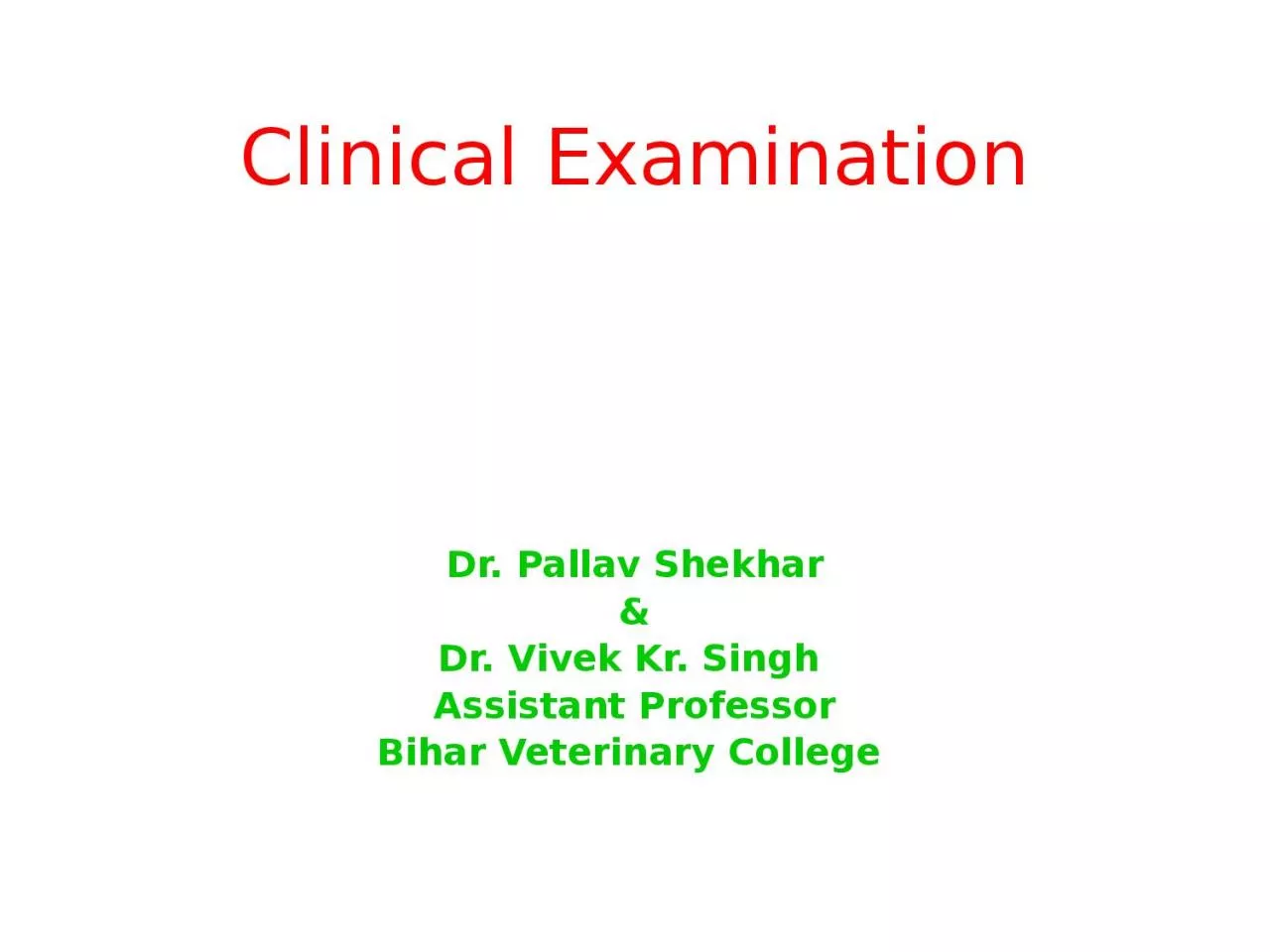

Pallav Shekhar amp Dr Vivek Kr Singh Assistant Professor Bihar Veterinary College Clinical Examination Distant Examination Physical Examination Distant Examination INSPECTION ID: 919102
Download Presentation The PPT/PDF document "Clinical Examination Dr." is the property of its rightful owner. Permission is granted to download and print the materials on this web site for personal, non-commercial use only, and to display it on your personal computer provided you do not modify the materials and that you retain all copyright notices contained in the materials. By downloading content from our website, you accept the terms of this agreement.
Slide1
Clinical Examination
Dr.
Pallav
Shekhar
&
Dr
. Vivek Kr. Singh
Assistant Professor
Bihar Veterinary College
Slide2Clinical Examination
Distant
Examination
Physical Examination
Slide3Distant
Examination (INSPECTION)
It means visual examination of the patient
from a
distance
It includes examination of
Behavior and general appearance
Behavior is a reflection of the animal’s
health
Separation
of an animal from its group is often an indication of illness
Slide4PHYSICAL EXAMINATION
PALPATION
Palpation
is an act of handling tissues, organs or parts of animal body. It is a
close physical examination
Slide5Types of palpation
Direct palpation
:
with the finger
Indirect palpation
:
with a probe
PERCUSSION
Percussion
is an act performed by
striking or tapping a part of the body
. In percussion, the body surface is struck so as to set deep parts in vibration and cause to emit audible sounds.
Slide6Direct or immediate :Performed with the fingers using one hand as a
plexor
/ percussion hammer
and other as a
pleximeter
Indirect or mediate
: performed using percussion hammer on a pleximeter disk in large animals
Slide7Ballottement: Ballottement is a technique used to detect floating viscera or masses in the abdominal cavity. Using the extended fingers or the clenched fist the abdominal wall is palpated vigorously with a firm push to move the organ or masses away and then allow it to rebound on to the fingertips
Ballottement / Tactile percussion = Palpation + Percussion
Slide8AUSCULTATION
Auscultation
:
It is a method of listening to the functional sounds produced by internal organs It is routinely used to assess heart sounds, lung sounds and gastrointestinal sounds
Slide9Direct
Auscultation
:
Direct listening to the sounds produced by organ movement. It is performed by placing the ear to the body surface over the
organ
Indirect Auscultation :
Indirect auscultation is performed with the aid of
stethoscope or phonendoscope
. It is the preferred technique
Slide10Parts of a stethoscope
:
Chest piece with diaphragm
Connecting/conducting tube
Ear pieces(2)
Slide11Succussion
This is also a combined method of physical examination where
shaking
of body from side to side and simultaneous auscultation are done to detect the presence of fluid
Slide12RECORDING OF BODY TEMPERATURE
Short bulb clinical thermometer
As a general rule the thermometer should be left in place for
2 minutes
Hyperthermia
is simple elevation of the temperature past the critical point, as in heat stroke.
Fever or pyrexia
is the state where Hyperthermia is combined with toxaemia, as in most infectious diseases
Slide13Hypothermia
,
a subnormal body temperature, occur in
shock
,
Circulatory collapse(as in parturient paresis and acute rumen impaction of cattle),
hypothyroidism
and
just before death
in most diseases
Slide14Species
Normal temperature
Critical point
Horse
36.6°C(99.5°F)
39.0°C(102.0°F)
Cattle
38.5°C(101°F)
39°C(103.0°F)
Calf
up to
1 year
39.2°C(102.5°F)
Pig
39.0°C(102.0°F)
40.0°C(103.5°F)
Sheep
39.0°C(102.0°F)
40.0°C(104.0°F)
Goat
39.5°C(103.0°F)
40.0°C(105.0°F)
Poultry
41.6°C(106.0°F)
Dog
38.5°C(101.5°F)
Cat
38.5°C(101.5°F)
Foal
38°C(100.5°F)
Slide15RECORDING OF PULSE RATE
Pulse is the expansion and elongation of the arterial wall imparted by the column of arterial wall due to contraction of
left ventricle
Slide16Species
Site
Cattle, buffalo
Middle coccygeal or facial arteries
Horse
External maxillary artery transverse facial
artery
Sheep and goat
Femoral artery
Dog
Femoral artery
Cat
Femoral artery
Pig(small)
Femoral artery
Pig(large)
Middle
coccygeal
Slide17Jugular pulse: Pulsation of jugular vein is known as jugular pulse. It is observed in the case of
traumatic pericarditis
in competence of tricuspid valve
Slide18Species
Pulse rate/ min
Adult horse
30-40
Foals up to 1yr
70-80
Adult cattle
60-80
Young calves
100-120
Sheep and goat
70-90
Pig(young)
60-90
Pig(large)
80-120
Dog(large)
70-90
Dog(small)
90-120
Cat
100-130
Fowl
130-160
Camel
32-50
Elephant
20-30
Slide19RECORDING OF RESPIRATORY RATE
Respiration
:
It is the inhalation & exhalation of air from the lung. The respiratory mechanism is
governed by respiratory centre
& the
centre is located in the medulla oblongata
Slide20Type of respiration
Thoracic respiration
: Thoracic muscles are predominantly involved in the process of respiration, observed in
dogs & cats
Thoraco-lumbar/abdominal respiration
: Both Thoracic & abdominal muscle are equally in respiration & observed in
horses, mule, donkey
etc
Abdominal respiration
: Abdominal muscles are predominantly involved & are observed in
cattle, buffalo, sheep & goat
Slide21Species
Respiration rate /minute
Species
Respiration rate /minute
Adult horses
8-14
Sheep & goat
18-30
Foals
14-16
Pig
16-18
Adult cattle
16-22
Dog
14-30
Young calves
27-30
Cat
20-30
Buffalo
22-28
Fowl
15-30
Slide22Prolongation of inspiration
is usually due to obstruction of
upper respiratory tract
Prolongation of the expiration
is often due to failure of normal lung collapse, as in emphysema (
Lower respiratory track
)
Slide23Examination of Mucous Membrane
Yellow
mucous membrane-
Jaundice
Pale and watery
-
anaemia
Pale and dry
-
shock
Brick red
-
arsenic poisoning
Bluish mucosa
-
cyanosis
Slide24